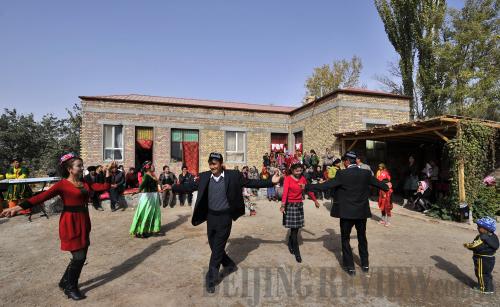|
 |
|
MARRIAGE IN NEW HOUSE: Neighbors dance happily to celebrate Nurman Guli's wedding in front of her newly-built house in Bacu County, northwest China's Xinjiang Uygur Autonomous Region (SHEN QIAO) |
On October 21, Nurman Guli, a woman from Bacu County, northwest China's Xinjiang Uygur Autonomous Region, got married in her new house. Everyone in the neighborhood was invited to celebrate.
This is a community with rows of newly built houses in Talaxiaor Village. A large project was launched in the region in 2004 to move rural residents from shantytowns to earthquake-resistant homes. The construction of this community was finished in 2011 and in early 2012 Guli and hundreds of other villagers moved into their new homes. So far, about 17,000 households in Bacu County have made the move.
The Xinjiang success
Xinjiang is prone to earthquakes. In the south of Xinjiang many rural residents lived in very simple shanties, which could not even withstand minor earthquakes.
In the past century, Xinjiang was struck by 104 earthquakes of magnitude 6 or above, including 14 tremors above magnitude 7 and two tremors above magnitude 8. In 2003, a magnitude-6.8 earthquake jolted Bacu County, killing 268 people and causing an economic loss of 1.37 billion yuan ($219 million). More than 80 percent of the loss came from housing damages.
In February 2004, the local government of Xinjiang decided to launch the project to build up seismic-resistant houses for rural residents, covering more than 1.2 million households in 49 counties and cities.
According to the project's plan, new quake-resistant houses will be built each year for 300,000 households. The government of Xinjiang organized a team to check the quality of the houses to ensure their quake-resistance ability. Until 2009, the government had invested as many as 51.2 billion yuan ($8.2 billion) to build anti-seismic houses.
The new anti-seismic houses sustained 33 earthquakes above magnitude 5 since 2004 and none of the houses collapsed in the earthquakes. On November 1, 2011, a magnitude-6 earthquake rocked the border area of Yining and Gongliu counties in south Xinjiang's Ili Kazak Autonomous Prefecture but no casualties were reported and the damage was very limited. "This should be largely attributed to the housing renovation project," said Chen Hong, Deputy Director of the Earthquake Emergency Management Department of the China Earthquake Administration.
Li Shuming, a resident in Gongliu County, moved from north China's Shanxi Province to Xinjiang 40 years ago. "I was 27 years old when I first moved here. Until 10 years ago, the village was pretty much the same as before," Li said. "Things have been getting better in recent years."
There are seven people in Li's family and they used to live in earth-walled houses for many years. "It is very uncomfortable. It was very cold in winter and always leaked during rain. I think it might have fallen down even without earthquakes," Li said.
In 2010, knowing about the quake-resistant housing renovation project, Li applied for and received 5,000 yuan ($801) in subsidies to build a new house. "At the very beginning, only a few people in the village wanted to renovate their houses because every household had to foot part of the costs, but they didn't want to spend," Li said.
After Li's new house was built, it became very popular among local villagers, especially when it rained as many other houses were leaking. Li once hosted more than 20 people in his house.
After the earthquake on November 1 last year, Li's house remained standing and suffered no damage. Other villagers were not so lucky: their homes either suffered major cracks or collapsed. "They almost all swarmed to my house and rushed afterward to build their own quake-resistant houses," Li said.
The government then decided to build up a new community for the quake-affected village and offered every household a subsidy of 45,000 yuan ($7,210). Li also moved into his new house. "It has a small courtyard and my son told me it is designed in a European style," Li said.
| 